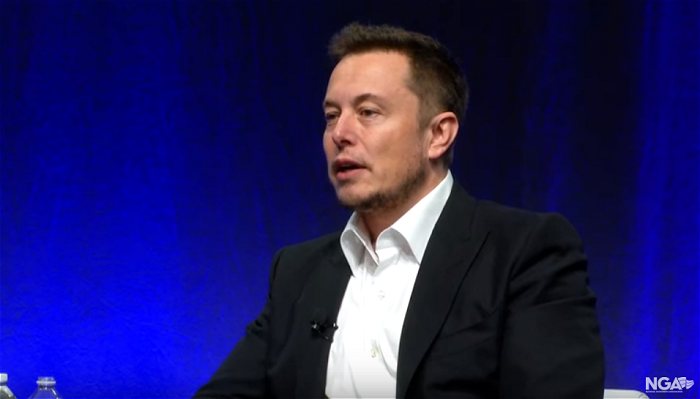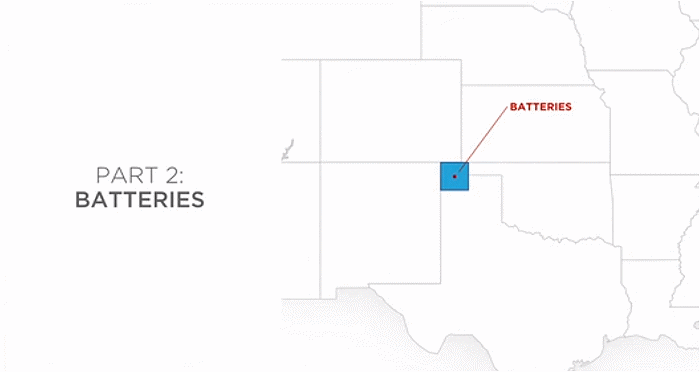
Tesla Founder And CEO Elon Musk | Image: National Governors Association
In an entirely solar powered USA, what would be the land area required for battery storage to ensure 24/7 electricity supply? Tesla’s Elon Musk says he has the answer.
In his keynote speech at the National Governors Association meeting a few days ago, Mr. Musk claimed the area needed to power the entire USA with solar panels would be around 160 kilometres by 160 kilometres.
As for the space required for battery storage, it would be “really tiny”.
“The batteries you need to store that energy to make sure you have 24/7 power is one mile by one mile. One square mile. That’s it.”
Here’s video of the section of Mr. Musk’s speech with the claims:
Elon Musk’s estimations are illustrative examples, not project proposals, just to provide an easier way for people to visualise how much land area he believes would be needed for both.
It’s not the first time Mr. Musk has made similar claims regarding the potential for solar panels and batteries to power the entire USA. In his 2015 Powerwall debut presentation, Mr. Musk used a chart to show the small areas required. The state shown is Texas, the blue square is the area occupied by solar panels and the dot in the middle the batteries.

Image source: Tesla and VideoMisery/Youtube
As to whether the claims check out, the UCL Energy Institute posted a fact-check regarding the solar panel aspect in 2015, stating the area shown was reasonable. It was stressed, however, the claim wasn’t whether the solar panels could meet second-by-second demand, but just if the total amount over time could be met.
The battery claim made on the weekend is yet to be scrutinised – and no doubt there’s some furious back-of-virtual-envelope calculations being performed.
Elon Musk has been enjoying even greater media attention since the recent announcement of Tesla’s 129 MWh battery project in South Australia. There’s a lot riding on this project being a success, both for Tesla and South Australia’s government.
Tesla will be required to have the battery project up and running within 100 days of the grid interconnection agreement having been signed, or the project will be delivered at no cost. South Australia will be depending on delivery of the project by summer to boost its energy system security.
The battery storage facility, which will be paired with Hornsdale Wind Farm near Jamestown, will provide stability services for renewables and be available to supply emergency back-up power if a shortfall in energy is predicted.

 RSS - Posts
RSS - Posts



Commercial batteries especially in South Australia that support renewable energy production makes sense for a whole raft of reasons least off all if only to break the stranglehold that a commercial generator of a particular class has in respect to a capacity to manipulate spot prices which on demand can go from $70 – $100 to more than $5,000 per megawatt.
When it comes to domestic storage there is now an additional energy credit dynamic to consider and that is the rising value of feed in. So now the question is do you use storage to reduce the amount of energy imported or a surplus of PV production to create a billing credit equal to or more than the imported energy and fixed charges. Both can achieve a similar financial outcome but one or the other depending on the cost and size of the system will produce a better return on investment [ROI].
For storage to work you need to be able to have enough excess PV required to meet consumption demands and have kWh left over and available to charge the battery. To optimise that for many may require an upgrade to the PV system which adds to the cost of installing storage.
As a pensioner and given that we get a QLD Government subsidy to achieve a zero bill that includes energy imported and fixed charges after charging and discharging a 1.2 kW battery we need an export to import ratio of about 4 – 5 export to 1 import in kWh.
Yesterday midnight to midnight we consumed 15.41 kWh produced 31.2 kWh imported 5.29 kWh exported 20.76 kWh. The daily cost without PV and subsidy would have been $5.55 annualised $2,025.24 and with PV and one 1.2 kW Battery 0.57c annualised $207.82 if I applied the QLD Pensioner subsidy then the daily cost would have been a credit amount of 0.33c daily annualised $122.15 in my favour.
Our projected average for July 2017 is 0.58c per day and for the quarter May – August 2017 1.43 per day [that includes feed in at 0.07c up to the 30th June and then 0.10c from 1st July 2017. I am expect this to improve in the next quarterly periods.
If that was a typical performance over 4 billing cycles I probably would not purchase any additional storage to offset the cost of importing energy. At the moment our average return on investment including the battery depending on the period being analysed [seasonal variations] is between 11 – 12 % APR Tax Free.
I have not taken into consideration GST not payed on the savings and PAYE Tax to gross up the savings.